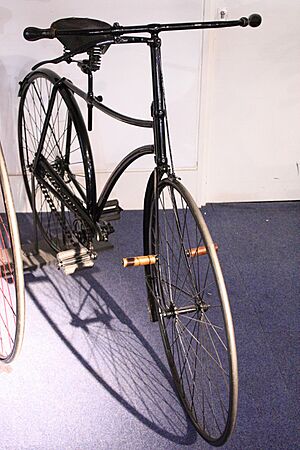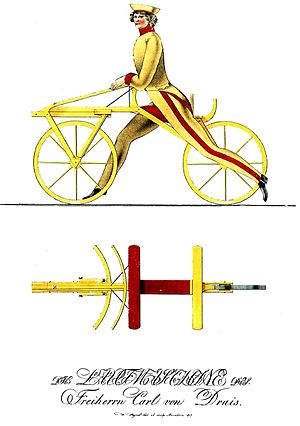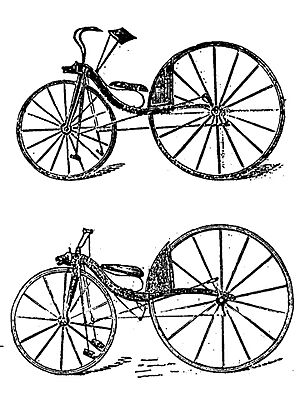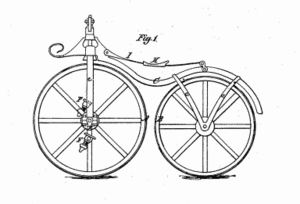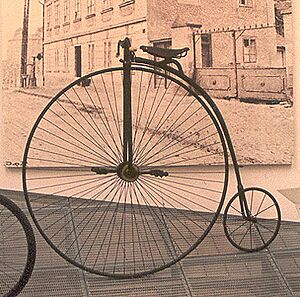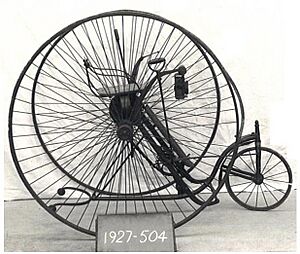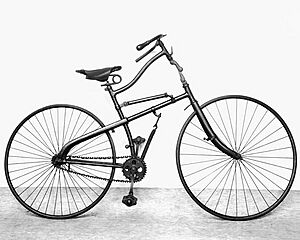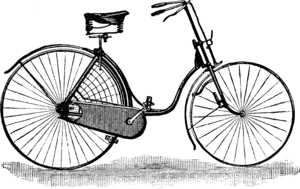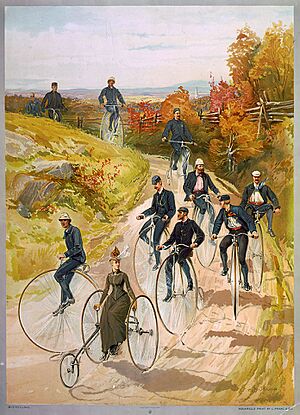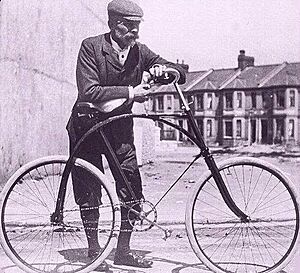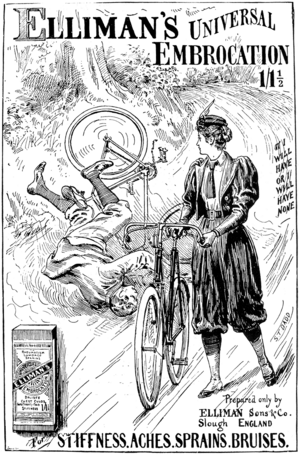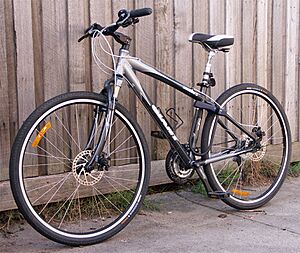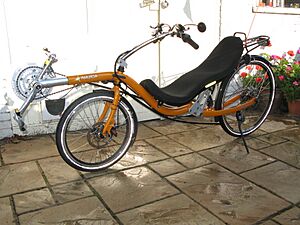History of the bicycle facts for kids
Bicycles are vehicles with two wheels that you balance on while riding. They first appeared in the early 1800s. The very first machine with two wheels in a row, like a bicycle, was the German draisine from 1817. The word bicycle was created in France in the 1860s. The name "penny farthing" for an "ordinary bicycle" also came from the 1800s.
Contents
Early Ideas for Bicycles
People have claimed to invent the bicycle very early on, but these stories are not fully proven.
A drawing from around 1500 AD was thought to be by Gian Giacomo Caprotti, a student of Leonardo da Vinci. However, experts now mostly agree it was a trick. Still, some people believe the drawing is real.
Later, in 1792, there was a story about a "Comte de Sivrac" who supposedly made a célérifère. This machine was said to have two wheels on a stiff wooden frame, but no steering. Riders would push it with their feet. Today, most historians think this two-wheeled célérifère never actually existed.
In Japan, a pedal-powered tricycle called '陸舟奔車 (Rikushu-honsha)' was described in 1732. But it was not developed further. Modern bicycles only came to Japan much later from Europe.
Bicycles in the 1800s
The Draisine: First Real Two-Wheeler (1817-1819)
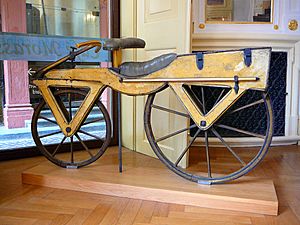
The first proven and practical bicycle was invented by German Baron Karl von Drais in 1817. He called his invention the Laufmaschine (German for "running machine"). The public and newspapers called it the Draisine or draisienne.
Drais patented his design in 1818. It was the first two-wheeled machine that you could steer and power yourself. People also called it a velocipede, hobby-horse, or dandy horse. It was first made in Germany and France.
Historians believe Drais wanted an alternative to horses because many died from hunger in 1816. That year was known as the "Year Without a Summer" due to a volcanic eruption.
On June 12, 1817, Drais rode his machine 13 kilometers (8 miles) in less than an hour. The draisine was mostly made of wood and weighed 22 kg (48 pounds). It had metal-covered wheels and a brake for the back wheel. Thousands were built and used, mostly in Europe and North America.
However, its popularity quickly faded. Many cities banned it because of accidents. Still, the Draisine is seen as the first bicycle, and Karl von Drais is called the "father of the bicycle."
A British inventor named Denis Johnson of London improved Drais's design in 1818. Johnson's machine was more elegant. Its wooden frame was curved, allowing bigger wheels without making the seat higher.
In the summer of 1819, Johnson's "hobby-horse" became very popular in London. Fashionable men, called dandies, loved it. But riders wore out their shoes quickly, and the trend ended within a year. Also, riders on sidewalks were fined.
Three and Four-Wheeled Vehicles (1820s-1850s)
After the draisine, people thought two-wheeled designs were too hard to balance. So, from the 1820s to the 1850s, many human-powered vehicles had three wheels (tricycles) or four wheels (quadracycles). These machines used pedals, foot levers, and hand-cranks. But they were often heavy and hard to roll.
Scottish Inventions (1830s)
Some people believe the first two-wheeled vehicle with mechanical power was built by Kirkpatrick Macmillan, a Scottish blacksmith, in 1839. His nephew later said Macmillan made a design where rods connected foot levers to a crank on the back wheel.
Supporters say Macmillan was involved in the first bicycle traffic offense. A Glasgow newspaper in 1842 reported that a "gentleman from Dumfries-shire" on a "velocipede of ingenious design" hit a pedestrian and was fined. However, it's not clear if this was Macmillan or if the vehicle had two wheels.
A similar machine was supposedly made by Gavin Dalzell around 1845. He likely copied the idea to help his drapery business. A copy of his machine is in the Riverside Museum in Glasgow, which displays the oldest bike known today. The first person to clearly document making rod-driven two-wheelers was Thomas McCall in 1869.
First Pedal Bicycle (1853)
Philipp Moritz Fischer, who used a draisine as a child, invented the pedal crank in 1853. He built the very first bicycle with pedals that year. However, he did not share his invention with the public. This original "Tretkurbelfahrrad" from 1853 is still kept and shown in a museum in Schweinfurt, Germany.
The Michaux "Velocipede" or "Boneshaker" (1860s)
The first widely successful bicycle design came from France around 1863. It became a popular trend from 1868 to 1870. This design was simpler than Macmillan's. It used pedals and cranks attached to the front wheel hub. Pedaling made it easier to go fast. But this design led to the very large front wheel of the "penny farthing" later on.
Using metal frames made the bikes lighter and more stylish. It also allowed them to be mass-produced. In England, this velocipede was nicknamed the "bone-shaker" because its stiff frame and iron-banded wheels made for a very bumpy ride.
The velocipede became popular again in Paris in the late 1860s. Historians agree that a French metalworker added pedals to the front wheel around 1864. The exact person who did this is still debated. Pierre Lallement and Ernest Michaux are two main people credited.
Bicycle historian David V. Herlihy says Lallement claimed to have made the pedal bicycle in Paris in 1863. He got the idea after seeing a draisine in 1862. Lallement filed the first and only patent for a pedal-driven bicycle in the US in 1866. His patent drawing shows a machine like Johnson's draisine, but with pedals on the front wheel. It also had a thin iron piece under the seat for a slightly smoother ride.
By the early 1860s, blacksmith Pierre Michaux was making "vélocipède à pédales" in small numbers. The wealthy Olivier brothers, Aimé and René, saw the potential of this new machine. In 1865, they rode a velocipede from Paris to Avignon in just eight days. They partnered with Pierre Michaux in 1868, forming Michaux et Cie. This was the first company to mass-produce bicycles. They replaced the early wooden frames with two pieces of cast iron bolted together.
Aimé Olivier, with a mechanic, created a stronger, single-piece frame made of wrought iron. As the first bicycle craze took off, many other blacksmiths started making bicycles with this new design. Velocipedes were expensive. When customers complained about the Michaux cast-iron frames breaking, the Oliviers switched to the stronger diagonal design. Michaux company continued to lead the industry.
Riding was easy on Paris's new paved boulevards. In the US, the machine was called the "bone-shaker." Later improvements included solid rubber tires and ball bearings. Lallement moved to the US in 1865 and patented the velocipede there. Its popularity grew in both Europe and the US. By 1868–69, the velocipede craze was strong even in smaller towns. Riding schools opened in many cities. The velocipede helped create a market for more advanced bicycles.
However, the Franco-Prussian war of 1870 stopped the velocipede market in France. The "bone-shaker" was only popular for a short time in the US, ending by 1870. One reason it failed in the US might be that American roads were much worse than European ones. Also, Calvin Witty bought Lallement's patent, and his demands for royalties made it hard for companies to sell bikes. The UK was the only place where the bicycle remained somewhat popular.
In 1869, William Van Anden invented the freewheel for bicycles. This allowed riders to stop pedaling while the wheel kept turning. At first, bicycle fans didn't like the idea. They thought it made the bicycle too complicated.
The High-Wheel Bicycle (1870s)
The high-wheel bicycle was a natural next step from the boneshaker. The front wheel became much larger to allow for higher speeds. Its size was limited by the rider's leg length. The back wheel became smaller, and the frame was made lighter. Frenchman Eugène Meyer is now considered the inventor of the high bicycle. He invented the wire-spoke tension wheel in 1869.
James Starley in Coventry, England, added tangent spokes and a mounting step to his famous "Ariel" bicycle. He is known as the father of the British cycling industry. Ball bearings, solid rubber tires, and hollow steel frames became standard. This made the bikes lighter and the ride much smoother. The front wheel could be up to 1.5 meters (60 inches) wide.
Later, when new designs appeared, this type of bicycle was called the "ordinary bicycle." It was also nicknamed "penny-farthing" in England. The large front wheel was like a penny, and the small back wheel was like a farthing (a smaller coin). These bikes were fast but unsafe. The rider sat very high up. If they hit a bump, they could easily be thrown over the front wheel, leading to serious injuries or even death. This was called "taking a header."
The rider's legs often got stuck under the handlebars, making it hard to fall clear of the machine. Because they were so dangerous, these bicycles were mostly ridden by adventurous young men. Older people preferred more stable tricycles or quadracycles. Also, women's clothing at the time made the "ordinary" bicycle hard to ride.
After the Franco-Prussian War, English companies like those in Coventry and Birmingham started selling the high-wheeler. It became very popular in England. Soon, these bicycles spread to other parts of the world, especially due to the British Empire.
In the United States, Albert Augustus Pope began making his "Columbia" high-wheelers in 1878. He gained control of most patents, starting with Lallement's 1866 patent. Pope lowered the fees for using the patents and took competitors to court. The courts supported him, so competitors either paid royalties or went out of business.
Pope also used mass-production methods, advertised a lot, and supported the Good Roads Movement. This movement helped improve roads, which in turn helped bicycle sales. Bicycle makers also started changing their models every year, like car companies do today.
Despite these changes, cycling remained mostly for wealthy city men until the 1890s.
The Safety Bicycle and the Bike Boom (1880s-1890s)
The invention of the safety bicycle was perhaps the most important change in bicycle history. It changed bicycles from being a dangerous toy for young men to a common way for everyone, men and women of all ages, to travel.
Besides being unsafe, the high-wheeler's direct front-wheel drive limited its speed. Inventors tried to solve this with a chain-driven front wheel, like the Kangaroo. They also tried a rear-wheel chain drive. Harry John Lawson invented a rear-chain-drive bicycle in 1879, but it still had a huge front wheel and a small rear wheel. It was not successful.
John Kemp Starley, James Starley's nephew, made the first successful "safety bicycle," called the "Rover," in 1885. He didn't patent it. It had a steerable front wheel, equally sized wheels, and a chain drive to the rear wheel.
The safety bicycle was widely copied and completely replaced the high-wheeler by 1890. Then, John Dunlop reinvented the pneumatic bicycle tire in 1888. This made for a much smoother ride on paved streets. Before this, safety bicycles were less comfortable than high-wheelers because of their smaller wheels. The pneumatic tire made the ride much better. Frame designers found that a diamond shape was the strongest and most efficient design.
On October 10, 1899, Isaac R Johnson, an African-American inventor, patented a folding bicycle. It was the first with a modern diamond frame, a design still used today.
The chain drive made riding more comfortable and faster. It moved the power to the non-steering rear wheel, allowing for smooth pedaling. With easier pedaling, riders could turn corners more easily.
The pneumatic tire and diamond frame improved comfort, but they were not crucial for safety. A hard rubber tire still works, but it makes the ride very bumpy. The diamond frame design allows for a lighter, simpler, and cheaper bike.
The first electric bicycle was likely built in 1897 by Hosea W. Libbey.
In the mid-1890s, bicycle sales were booming despite a tough economy. Many manufacturers started making bikes. This led to too many bikes being made, strong price competition, and eventually, many companies failed as the bicycle bubble burst.
Bicycles in the 1900s
The Roadster Bicycle
By the 1890s, the ladies' version of the roadster was well-designed. It had a step-through frame instead of the diamond frame of the men's model. This allowed ladies, wearing dresses and skirts, to easily get on and ride. It often had a skirt guard to stop clothes from getting caught in the back wheel. Like the men's roadster, the frame was steel. The frame and handlebars made the rider sit very upright. Early models had front spoon-brakes, but later ones had better coaster brakes or rod-activated rim/drum-brakes.
The Dutch bicycle industry grew quickly from the 1890s. Since Britain had the best bike designs, Dutch frame makers either copied them or imported them from England. In 1895, 85 percent of all bikes bought in the Netherlands were from Britain. You can still see this influence in the strong, traditional shape of a Dutch bike today.
While the ladies' roadster became less popular in England and other Western countries, it stayed popular in the Netherlands. This is why some people call bikes of this design "Dutch bikes." In Dutch, they are called Omafiets ("grandma's bike").
Bikes in Europe and the US
Cycling became more important in Europe during the first half of the 1900s. But in the United States, bicycle use dropped a lot between 1900 and 1910. Cars became the main way to travel. By the 1920s, bicycles were mostly seen as children's toys in the US. By 1940, most bikes in the US were made for kids. In Europe, cycling remained an adult activity. Bicycle racing, commuting, and touring were all popular.
From the early 1900s until after World War II, the roadster was the most common adult bicycle sold in the UK and many parts of the British Empire. For many years, even after motorcycles and cars appeared, they were a main way for adults to get around.
New Bike Technologies
Bicycles kept changing to fit different riders' needs. The derailleur system, which allows changing gears, was developed in France between 1900 and 1910. It improved over time. Only in the 1930s did European racing groups allow racers to use gears. Before that, racers had to use two-speed bikes. To change gears, they had to stop, take off the back wheel, flip it around, and put it back on. When derailleurs were allowed, racing times immediately got faster.
Bikes in World War II

Even though multi-speed bikes existed, most military bicycles used in World War II had only one speed. Bicycles were used by paratroopers for transport. This led to the term "bomber bikes" for US planes dropping bikes for troops. German Volksgrenadier units had bicycle infantry. During the Invasion of Poland, many bicycle-riding scouts were used.
In the Second Sino-Japanese War, Japan used about 50,000 bicycle troops. The Malayan Campaign also saw many bicycles used. Japanese soldiers took bicycles from civilians because there were so many. Japanese bicycle troops were fast and could carry a lot of equipment. They could carry 36 kg (79 pounds) of gear, compared to a normal British soldier who carried 18 kg (40 pounds).
China and the Flying Pigeon
The Flying Pigeon bicycle was very important in China. It was the government-approved way to travel. China became known as the 'Kingdom of Bicycles'. A bicycle was one of the three "must-haves" for every citizen, along with a sewing machine and a watch. These items showed a hint of wealth. The Flying Pigeon became a symbol of a fair social system that offered a reliable ride through life.
In the 1960s and 1970s, the Flying Pigeon logo was on almost all bikes in China. It became the most popular vehicle in the world. Deng Xiaoping, China's leader after Mao Zedong, even said that prosperity meant "a Flying Pigeon in every household."
In the early 1980s, Flying Pigeon was China's biggest bike maker. In 1986, it sold 3 million bikes. Its 20-kilogram (44-pound) black single-speed models were popular with workers. There was a waiting list of several years to get one. Buyers also needed good connections (guanxi) and the money, which was about four months' wages for most workers.
North America: Cruiser vs. Racer
In the mid-1900s, there were two main bicycle styles for fun riding in North America. Heavy cruiser bicycles were popular for their strength, comfort, and many accessories. They had wide "balloon" tires, pedal-driven "coaster" brakes, and only one gear. Lighter bikes, with hand brakes, narrower tires, and three-speed hub gears, often imported from England, became popular in the US in the late 1950s. These bikes often had lights, reflectors, kickstands, and tire pumps. In the UK, like the rest of Europe, cycling was more about getting around, so lightweight but strong bikes were preferred.
In the US, the sports roadster was imported after World War II and called the "English racer." It quickly became popular with adults looking for an alternative to the children's cruiser bicycle. The English racer was not a true racing bike, but it was faster and better for hills than the cruiser. This was thanks to its lighter weight, tall wheels, narrow tires, and internal gears. In the late 1950s, US makers like Schwinn started making their own "lightweight" versions of the English racer.
In the late 1960s, Americans became more aware of exercise and energy-efficient travel. This led to the American bike boom of the 1970s. Annual US sales of adult bicycles doubled between 1960 and 1970. They doubled again between 1971 and 1975, reaching almost 17 million bikes.
Most of these sales were to new cyclists. They mostly preferred models that looked like popular European racing bikes. These were called sports models, sport/tourers, or simply ten-speeds. These lighter bikes had dropped handlebars, narrow tires, derailleur gears, five to fifteen speeds, and a narrow racing seat. By 1980, racing and sport/touring bikes dominated the market in North America. The Fatbike was invented in 1980 for off-road use.
Bikes in Europe
In Britain, the common roadster became less popular in the early 1970s. A boom in recreational cycling made manufacturers focus on lightweight, affordable derailleur sport bikes.
In the early 1980s, the Swedish company Itera invented a new type of bicycle made entirely of plastic. It did not sell well.
In the 1980s, UK cyclists started moving from road-only bikes to all-terrain models like the mountain bike. The mountain bike's strong frame and ability to carry loads made it useful as a utility bike. By 1990, the roadster was almost gone. While UK bicycle sales reached a record 2.8 million, almost all were mountain and road/sport models.
BMX Bikes
BMX bikes are special bicycles, usually with 16 to 24-inch wheels (20-inch is common). They started in California in the early 1970s. Teenagers copied their motocross heroes on their bikes. Kids raced standard road bikes off-road on special tracks. The 1971 motorcycle racing movie On Any Sunday helped inspire this trend in the US. It showed kids riding their Schwinn Sting-Rays off-road. By the mid-1970s, the sport grew, and companies started making bikes just for BMX.
BMX has grown into an international sport with different styles like Freestyle, Racing, Street, and Flatland.
Mountain Bikes
In 1981, the first mass-produced mountain bike appeared. It was made for riding off-road on different surfaces. It was an instant success. Sales boomed in the 1980s. People liked the idea of all-terrain cycling and wanted to escape city life through mountain biking and other extreme sports. These bikes had stronger frames, wider tires with big knobs for grip, and a more upright seating position. They also started to have front and rear suspension. By 2000, mountain bike sales were much higher than racing or touring bikes.
Bicycles in the 2000s
The 21st century has seen more technology used in designing, building, and using bicycles. Bike frames and parts continue to get lighter and more aerodynamic without losing strength. This is thanks to computer aided design and other computer tools. New discoveries about bicycle stability have been made using computer simulations. New manufacturing methods like hydroforming are also used. Electronic gadgets have expanded from just cyclocomputers to include cycling power meters and electronic gear-shifting systems.
Hybrid and Commuter Bicycles
Recently, bicycle designs have become more specialized. More people are cycling for fun, recreation, and commuting. For these groups, the industry created the hybrid bicycle. It's sometimes called a city bike, cross bike, or commuter bike. Hybrid bikes combine features from road racing and mountain bikes.
Hybrid and commuter bicycles can be fast and light, like racing bikes with flat handlebars. Or they can be wider-tired bikes designed for comfort, carrying loads, and riding on different road surfaces. Enclosed hub gears have become popular again. They now have up to 8, 11, or 14 gears. They are easy to maintain and have improved technology.
Recumbent Bicycles
The recumbent bicycle was invented in 1893. In 1934, the Union Cycliste Internationale banned recumbent bicycles from official races. This happened after a less-known rider, Francis Faure, beat world champion Henri Lemoine and broke a speed record while riding a recumbent bike. Some people say this ban stopped the design of upright racing bikes from changing for 70 years. This changed when the International Human Powered Vehicle Association was formed. This group holds races for "banned" types of bicycles. Sam Whittingham set a human-powered speed record of 132 km/h (82 mph) on a recumbent streamliner in 2009.
Historically, most bike frames were steel. But recent designs, especially for high-end racing bikes, use a lot of carbon and aluminum frames.
In recent years, there has also been a new interest in balloon tire cruiser bicycles. People like their simple comfort, reliability, and style.
Besides trends from American cycling, European, Asian, and African cyclists still use traditional roadster bicycles. Their strong design, covered chain guards, and reliable hub gearing make them great for commuting and everyday use.
See also
- Bicycling and feminism
- Bike boom, also known as "bicycle craze", a name used for several periods in cycling history
- Cyclability
- Hour record
- Timeline of transportation technology
- Electric bicycle
|


